-
The Outer Hebrides North
On our first day in Stornoway, we did stones. Standing stones. A big circle of them. At Calanais. It was only 13 miles from our hotel, but then everything is nearby on Lewis, as it is only about 40 miles long and 35 miles wide.
The stone were impressive, though.
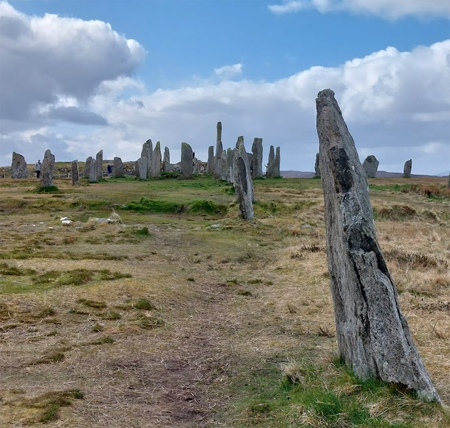
Impressive Stones The Fair-Weather Fairy continued to bless us with fluffy white clouds and blue sky. And it was warm. In April. In Lewis. I had my Viking Jumper on and my winter-lined waterproof to hand, and I was sweating. This was not the weather we had planned for, but I was certainly not going to complain.
The scenery was monotonously stunning, there was hardly a breath of wind, and the silence, so unimaginably deep, made the setting quite magical.

Foundations, like the one in the foreground, are dotted all over the island and are the remnants of farm buildings that fell into ruin after the Highland Clearances We visited a Broch, which is a big pile of rocks that people used to live in. We saw a few in Shetland, and this one looked pretty much the same (you see one big pile of rocks and you’ve pretty much seen them all). This one, however, was half gone, which allowed us to see how the structure was put together.
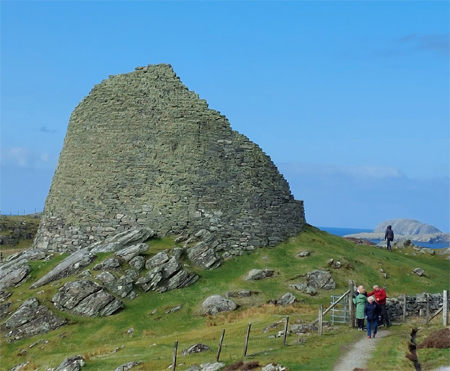
Half a Broch And some of us ventured inside the walls—where it helped to be agile and short—to climb to the top for a panoramic view.
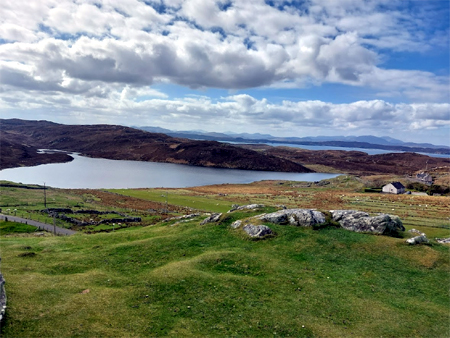
Nice view, though After that, we visited The Black Houses, which Peter May wrote about in his Lewis Trilogy. They are stone and thatch houses that the islanders used to live in back in the day and are now a sort of living museum. In one, we got to see how the more recent occupants lived, which was not all that long ago: it was panelled, there was a fireplace, a spinning wheel, and a sewing machine, and looked about as comfortable as you could make something made out of stone and thatch.
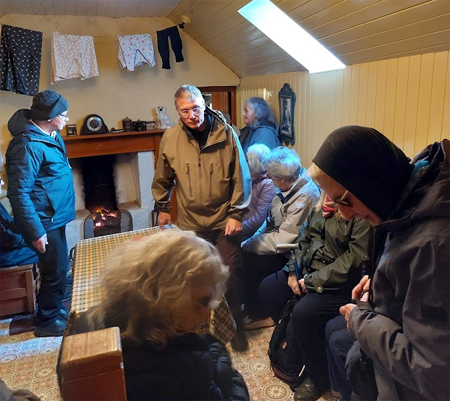
Comfortable, but cramped In another, more rustic house, a man demonstrated how to operate a loom to make Harris Tweed (available in the Gift Shop).
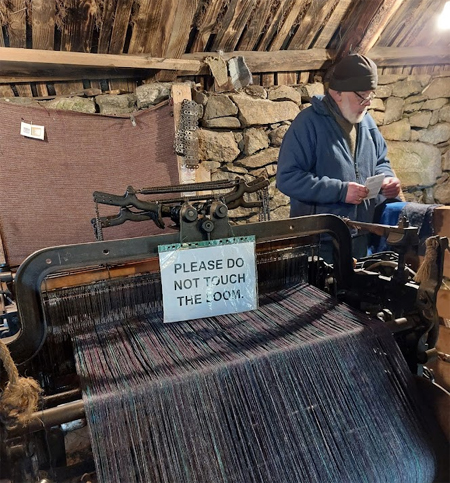
Making Harris Tweed, but don’t touch it Our final stops of the day involved an ancient flour mill that had been in use for hundreds of years—without any obvious attempt to modernise it—and was only abandoned in the 1960s, and a Shielding—a place for travellers to rest for the night—which took all of five minutes.
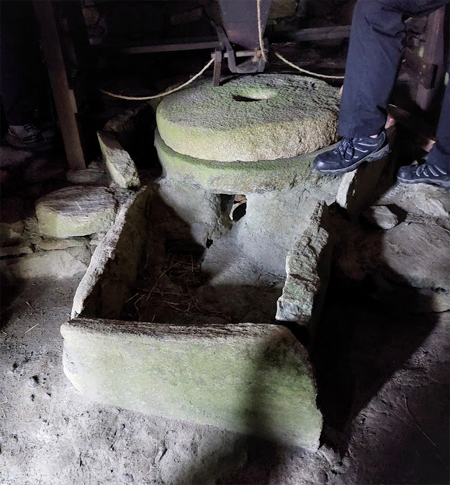
This was in use until the 1960s And, as a bonus, we took a side trip to another, rather sombre, memorial:
On New Year’s Day, 1919, the Iolaire, carrying 283 men—soldiers who had survived the horrors of the First World War, as well as the ravages of the Spanish Flu—made the final turn for home into Stornoway Harbour. Perhaps they were too eager to get home, or perhaps the gale blowing at the time pushed them a bit off course, or perhaps it was a combination of the two, but the result was, the ship struck rocks and sank with the loss of 205 of those aboard. It basically wiped out an entire generation of the island’s young men. Most of those who survived had John F. MacLeod to thank. He swam through the storm carrying a heavy line, which 40 of the men used to pull themselves to shore.

Stornoway bay and the memorial to the Iolaire which represents the rope John MacLeod used to save some of the men Our final day took us to the Butt of Lewis, which is actually the Head of Lewis, being at the extreme northern end. And once again, the weather cooperated. It really would have been less of a holiday if the rain—which we expected and prepared for—did materialize. Seeing the beaches, the stunning cliffs, the rolling landscapes—none of that would have been half as picturesque if rain had been pelting down.
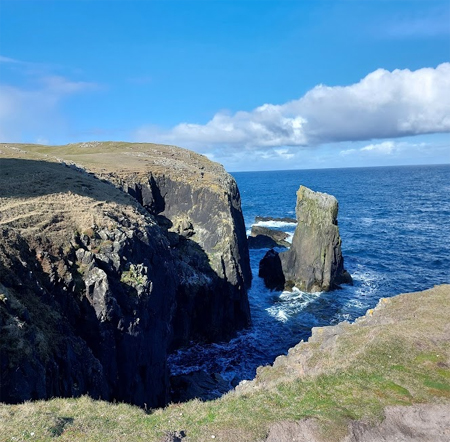
This was really stunning Also, it accentuated the quiet, the openness, the emptiness, and the vastness, which was so amazing in the sunshine and under blue skies.
Oddly, as soon as we drove into Stornoway, all that melted away. It was like we were back in civilization, with shops and pubs, and buses, and street signs. You could imagine living there, and not missing much of anything. It doesn’t take long, however, to leave all that behind. Stornoway is relatively small, so travelling in any direction soon finds you in empty desolation, or the ocean.
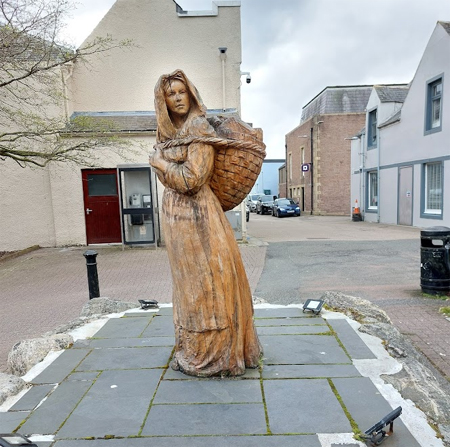
Our guide told us to be on the lookout for statues like this in Stornoway which were to commemorate the “Herring Girls” who followed the ships up down the coast; until I saw this stature, I thought that was a euphemism for prostitutes Left to our own devices, we spent about fifteen minutes in the museum and didn’t even bother looking at the castle. It’s not very old, having been re-built by the Victorians, and is mainly used as a conference centre. The museum was small but very nice, though the Chessmen were disappointingly small.
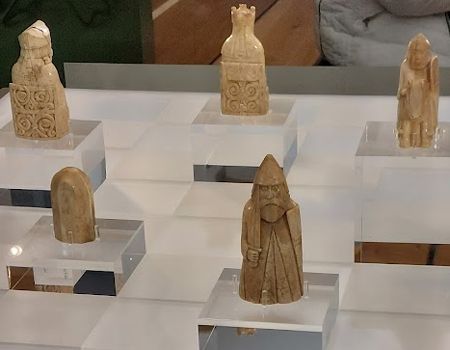
The Lewis Chessmen, created in the 12th century, discovered in 1831, and disappointingly small … As with the Black Houses, I only know of the chessmen from Peter May’s Lewis Trilogy. For some reason, the books left me with the notion that the Chessmen were about three feet tall. I’m not sure how that happened but, in reality, they are about as tall as your average chess piece, which is around two to three inches.

… except for this one, which they brought out specially for me After leaving the museum, we walked into Stornoway, had some cake and coffee, and fulfilled my main holiday objective of buying something outrageously expensive in Harris tweed. I got a jumper, and my wife bought a tunic. And they weren’t as expensive as I had expected them to be, so it was a successful, and cost-effective, trip.

The mark of excellence